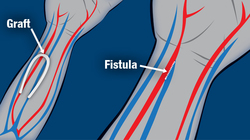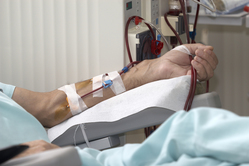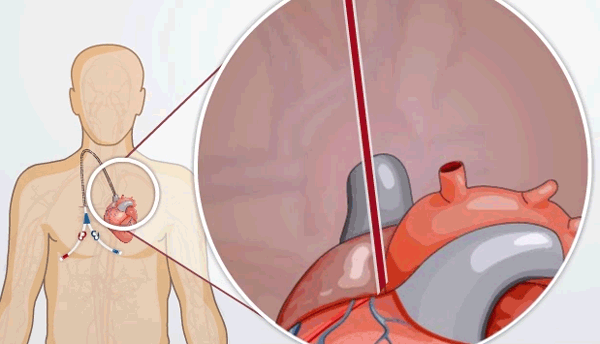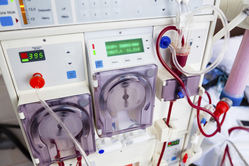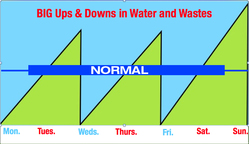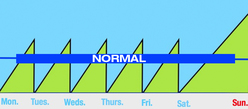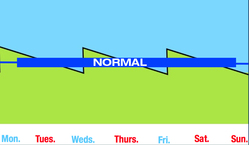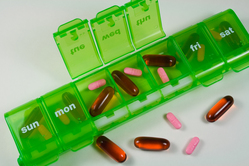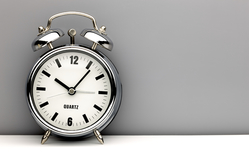The Home HD Option
Home hemodialysis (HD) is a way to replace the function of kidneys that don’t work. HD can be done at home in one of three ways:
- Three days a week for about 4 hours (standard home HD)
- Five to six days a week for 2.5 to 4 hours (short daily HD)
- Three to six nights a week for about 8 hours (nocturnal home HD)
HD at home is flexible. You can do it on your own schedule with your loved ones around you. Someone from your clinic will do a home visit to help you get set up.
You will need a partner who can be there while you do your treatments. The VA offers support for care partners. A nurse trains you and your partner until you are confident that you know what to do. And, you don’t need to buy the machine or your supplies. The VA will supply them for you. After training, instead of going to the clinic three times a week, you will come in once a month or so to meet with your kidney care team. The VA pays for home health care.
Hemodialysis Access
All HD requires a way to take blood out of the body to be cleaned, and then put it back in. This is called a vascular access, or just access. There are three types of access:
- A fistula, which is your artery + your vein
- A graft, which is your artery + your vein + a piece of man-made vein
- A catheter, which is a plastic tube placed into a large vein that ends in your heart
A fistula is the safest type, if you can have one.
HD Access: Fistulas
Dialysis needs the strong blood flow of an artery (the blood vessels that carry blood away from the heart). But veins (the blood vessels that carry blood to the heart) are closer to the surface of your skin and easier to reach. Linking an artery to a vein gives you the best of both: strong blood flow that is easy to reach.
Some ways of linking the artery and vein to make an access for HD are better than others. A fistula connects your artery directly to your vein. A graft connects an artery to a vein with a piece of man-made vein.
Fistulas can last the longest (sometimes decades) and they have the least chance of developing blood clots or infections that could put you in the hospital. If you want to do HD, a fistula is ideal. Plan ahead! A fistula needs to be made at least a few months before dialysis starts, so it has time to “mature” and be ready to use. It is wise to get a fistula made about 6 months before you need to start HD.
HD Access: Catheters
HD catheters are plastic tubes that are placed in a large vein in the neck, chest, or groin. They are used if someone needs dialysis right away, or has no other choice. A catheter is partly out of your body & partly inside your blood vessels. The tip is in your heart.
Catheters have several problems:
- Germs can climb up the tubing and get into your bloodstream. If this happens, a serious blood infection, called sepsis can occur.
- Catheters are linked to a risk of death that is many times higher than other types of HD access.
- Catheters can’t get wet. So, you may not be able to shower with an HD catheter.
- There may be a scar where the catheter enters your body.
HD Cleans Your Blood Outside Your Body
When you do HD, two needles are placed in your access. A nurse or technician connects the needles to tubing that carries your blood to a dialyzer, or artificial kidney. The dialyzer has filters inside to clean your blood. Wastes and extra water are removed, and then your cleaned blood comes back to you. A blood pump pushes your blood through the tubing at a rate that your doctor prescribes.
Three Ways to Dialyze at Home
As you learned, there are three ways to do HD at home:
-
“Standard” home HD is done three times a week, or every other day to get rid of the 2-day gap with no treatment. Each treatment lasts about 4 hours, but some people choose to do longer treatments at home (with their doctor’s prescription).
-
Short daily home HD is done 5 or 6 days a week for about 2.5–4 hours at a time. Water and wastes are removed nearly every day. Most people who do short daily treatments say they feel better than they did on standard treatments.
-
Nocturnal home HD is done at night while you sleep, for about 8 hours. This means that your days are free to do other things. People who use this treatment say they have more energy and they feel good. Some do nighttime treatments three nights a week or every other night. Some do four or five or six nights a week if their doctor prescribes it.
Standard HD: Big Ups & Downs
Between dialysis treatments, wastes build up in your blood. If you have a 4-hour treatment on Mondays, Wednesdays, and Fridays, you have no treatment on Tuesdays, Thursdays, Saturdays, or Sundays. This schedule leads to waste and water build-up between treatments. The ups and downs when wastes and water build up are biggest when treatments are only three times a week. When treatments are longer and/or more frequent, there is less time for water and wastes to build up. This is easier on your heart and means that you may feel better, too.
If you do standard treatments at home, you can talk to your care team about doing longer treatments or doing them every other day to reduce the ups and downs.
Nocturnal HD at Home: Very Small Ups & Downs
Since nocturnal treatments are longer than standard ones, they can remove much more water and wastes from the blood. In fact, the treatments are about twice as long. This means that fluid removal is very gentle, as you can see from the very small spikes in water and wastes (green) in the picture. So, even with three treatments per week, you may feel better from day to day, with few symptoms from kidney failure. With their doctor’s prescription, some people who do nocturnal HD at home do treatments every other night, or even 4, 5, or 6 nights a week. This is the most dialysis you can get.
Home HD and Your Lifestyle
Now that we’ve seen the basics of the three ways home HD works, let’s look at how home HD might affect your life in the areas of:
- What you can eat and drink
- How many medications you might need to take each day
- How much control you would have over your time
- How work-friendly home HD is
- How travel-friendly home HD is
- How home HD may affect your sex life and ability to carry or father children
Home HD: Few Limits on Diet or Fluids
The more dialysis you get, the closer to normal your diet and fluids can be. So, of the three ways to do home HD:
- Standard home HD will have the most diet limits, because the treatments are just done 3 days per week or every other day.
- Short daily and nocturnal HD have fewer limits, because treatments are longer or done more often.
Your dietitian will go over your lab test results with you each month. If your levels of potassium or phosphorus are too high, you may need to limit foods that have these minerals—like chocolate. To learn more about lab tests, visit the Laboratory.
Home HD: Fewer Medications?
The more dialysis you get, the fewer medicines you may need to take. So, of the three ways to do home HD:
- Standard home HD requires the most medicines—half of the people who do it need to take 19 pills a day, and about one in four need even more.
- Short daily HD means fewer blood pressure pills and phosphate binders for most people who do it. This can cut your pill count by quite a bit.
- Nocturnal HD may mean that you don’t need blood pressure pills or phosphate binders. In fact, some people who do nocturnal HD need to take phosphate supplements because the long treatments remove so much phosphate.
On any form of HD, you may need EPO to help treat anemia. If you have diabetes or other health problems, you will still need to take prescribed drugs for them, though the dose may change when your kidneys don’t work.
Home HD and Your Schedule
A treatment for kidney failure that you can do at home, like any form of home HD, gives you control of your schedule. You DO have to do all of your treatments to feel your best. But, you can choose to do them in the morning, afternoon, or evening. You can shift the days of the week to go to a special event, too.
Home HD and Your Job
Do you want to be able to work? A work-friendly treatment:
- Is not scheduled during the work day—or can be done at work
- Does not cause symptoms that might make you miss work
- Reduces the chance that you will need to go to the hospital—and miss work
- Helps you to have enough energy to work
Home HD can be work-friendly for all of these reasons. You can schedule it around your work hours, so it doesn’t get in the way of work. The more dialysis you get, the less likely you are to have symptoms from dialysis that cause you to miss work. (You may still have symptoms from the illness that caused your kidneys to fail, though.) People who do home HD say that they have more energy. Studies find that they tend to sleep and eat better, too.
Home HD and Travel
When you do HD at home, one way to travel is by finding a clinic at your destination that has a time slot open and can take you. This is done a few months ahead of when you want to travel, and your social worker can help you. You will need to be up-to-date with your vaccines.
If you use a small, more portable machine for home HD, you may be able to bring it with you on a car trip, or on a plane or boat. Your supplies can be shipped to you for free in the continental U.S.
Home HD, Fertility, and Your Sex Life
People who choose short daily or nocturnal home HD say that their sex lives are better than they were with standard in-center HD. Some women of childbearing age have been able to carry babies to term doing short daily or nocturnal HD, though a pregnancy with dialysis is always high risk.
More HD: Survival May Compare to Transplant
Doing HD at home puts you in charge. And, you are not exposed to so many others who may be ill. Only you or a partner put in your dialysis needles. These are pluses of home HD that may help improve your health.
Studies have found that people who do short daily or nocturnal HD may do even better. They may live about as long as those who get a deceased donor kidney transplant.
Statistics apply to groups, not to individuals. Some people have lived for decades on standard in-center HD and PD, too! But, it makes sense that more dialysis keeps your body in better balance and protects your heart.
Home HD: Things to Consider
There are things to think about when you do home HD. You’ll need a partner who can be there when you do your treatments. It’s best if you can do as much of your treatment as you can yourself—especially putting in your own needles. But a partner can help you with some of the tasks of the treatment or supplies, give you emotional support, or both. In most cases, a partner for home HD is a family member.The VA offers support for care partners. If you don’t have a family member who can be a partner and you want to do home HD, the VA may pay for a home dialysis helper in some cases. Talk to your care team about home health care.
You’ll need to set up a room in your home to do your treatments. Your care team can do a home visit and help give you tips about what has worked for others. Your treatment room may need changes to the wiring or plumbing, and the VA can help you with these. Ask your VA social worker about home improvements and structural alterations (HISA) grants to help with home changes needed for a dialysis machine.
Dealing with HD Needles
Fistulas and grafts for HD use needles. If needles bother you, there are lots of things that can be done to help:
- You can put a numbing cream on your skin 1–2 hours before treatment. Some numbing creams are prescription and some are not. Talk to your care team.
- A freezing spray can numb just the top of your skin very quickly.
- You can try to relax and take deep breaths.
- Putting in your own needles puts you in charge and distracts you, so the needles hurt much less. No one else can put in your needles as well as you can—you are the only person who can feel both ends of the needle. When you do home HD, it’s best if you put in your own needles. The clinic staff will teach you how, or will teach your partner if you can’t do it yourself.
- The “Buttonhole technique” is a way of putting dialysis needles into the exact same spots each time to form tunnel tracts (like pierced earring holes). Once Buttonholes form, you can use blunt needles for dialysis, for less pain.

You've reached the end of this topic:
Hemodialysis at Home
- The benefits of home hemodialysis (HD) may include:
Not scored Home HD puts you in charge, with your care team to back you up. Doing home HD can help you keep a job. You can eat more of what you love, and drink more fluid, too. And, if your treatments are longer and/or more frequent than three times a week, home HD can also be more gentle.
- Short daily HD is a treatment option that is done:
Not scored Most short daily HD is done at home, but a few clinics do offer it as an in-center option.
- Doing nighttime (nocturnal) HD at home may mean you need fewer of these medications:
Not scored Nocturnal HD at home does a great job of keeping blood pressure and phosphorus in control. So, most people who use this treatment don’t need to take blood pressure pills or phosphate binders.
- Something that you will need to do home HD is:
Not scored Most programs that offer home HD will require you to have a partner. If you don’t have one, talk with your VA Social Worker. In some cases, the VA may pay for a partner to help with home HD.
- Home HD may help your sex life and/or fertility:
Not scored There is not a lot of research on this, but people who do these treatments say that their sex lives are more active. And, some women have been able to have babies while getting 20 hours of HD per week.














